![]()
Remembering Ed Wilkes
Ned Groth, June 2018
(Author’s note: Unlike most of our faculty memorials, this biographical remembrance represents a real team effort, described below. Ed died in 1967, but I had not attempted a memorial because quite honestly I did not know enough about him. A conversation with Frank Phillips, who knew Ed for a few years after Darrow, got things started, then the research effort really gained momentum when Peter and Virginia Gorday got involved. Their contributions and sources are detailed in what follows. The goal, as always, has been to create an honest and loving portrait of our former master. As the primary author, I’ve striven for factual accuracy but take full responsibility for any errors. –NG)
Note: An addendum to this remembrance by Ned Groth appears at the end of this piece, here.
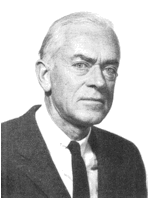
This yearbook photo matches my memories of him perfectly: Tall, slender, an elegant gentleman with a patrician air and a military bearing. Always impeccably and fashionably dressed. White hair, bushy brows and piercing blue eyes beneath a high forehead. Formidably intelligent yet soft-spoken in a deep, raspy voice.
This was our freshman history teacher, Edward Noble Wilkes, Jr. And what a teacher he was. I confess to not understanding at first why Darrow expected us to learn Ancient History. Wasn't that what museums were for? It took only a few days in class, however, for me to get hooked. Mr. Wilkes was extremely knowledgeable, but more notably, he brought the subject matter to life. As I listened to him describing how the ancient Greeks and Romans understood their gods, or how they each designed systems of government, it became clear that these lessons helped us decipher the world of 1958, too.
Wilkes was exceptionally good at getting us engaged with the material. Everyone has his own memories of when and how he learned something in Wilkes's class. I remember his mnemonic for the name of a certain Greek playwright, "Euripides pants, I busta you crust." I remember the story of Demosthenes, a famed Greek orator, who overcame a speech impediment in his youth. As Wilkes told it, Demosthenes went out to the sea shore, filled his mouth with pebbles, and practiced speaking clearly enough to be heard over the crashing waves. I remember Ed walking back and forth across the front of the class, gesticulating with his arms as if speaking to a huge crowd. I can almost swear (almost) that he filled his own mouth with marbles so we could hear what it was like for someone to try to talk that way.
Josh Weiss '63 wrote, "Ed Wilkes made the centuries come alive. 'Gosh, Fellas, can you just imagine?' The intonations of his voice used to emphasize whatever point he was putting forth. I can hear, most clearly, in his baritone, 'I am Ozymandias, king of kings. Look on my works, ye mighty, and despair!' How it is that I hear that in my head, nearly 60 years later, is a mystery. My recall is that he often spoke of these historical elements as though we were in the bleachers. He made us feel that the events were happening in the here and now. Wilkes would read or quote passages with such enthusiasm, such passion, that I began to look forward to his class (first thing in the morning, too.) I fell in love with history from then on."
Grown-up, Josh made his career in the men's tailored clothing business, so his observations of Ed's style may also deserve some weight: "He was impeccably dressed in tweeds every day. His necktie, collar pin and perfectly fitting suits coupled with a model's physique and faultless grooming made for quite 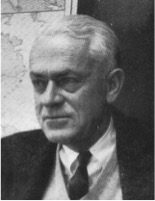 something to look at. He was a handsome man of, I'd say, 60 with beautiful blue eyes. I don't think he ever removed his suit coat, unlike Henderson who looked like an unmade bed, never had his jacket on in class."
something to look at. He was a handsome man of, I'd say, 60 with beautiful blue eyes. I don't think he ever removed his suit coat, unlike Henderson who looked like an unmade bed, never had his jacket on in class."
Peter Schaaphok, Class of '67, was the senior giving a chapel talk at Sunday Vespers on March 12, 1967, the day after Ed Wilkes died. (Unexpectedly—he had a heart attack.) Peter eulogized Ed, calling him "one of the finest teachers ever to come to Darrow." "I can still perfectly recall the intricate and fascinating details with which Mr. Wilkes would explain an ancient and almost forgotten campaign," Peter wrote, as printed in the Peg Board. He recounted having run into one of his old teachers from seventh grade, who had been a student at Governor Dummer Academy when Wilkes was teaching there (1945-53, between his stints at Darrow). Peter asked him whether he had ever had Wilkes as a teacher. The man's eyes lit up. "You just don't forget someone like Mr. Wilkes," he said.
Peter recounted a story Ed told them once in class about a personal adventure (one hopes not a personal fantasy). It had happened in the early years of World War I, when Ed was about 19 years old. He was serving in a reserve cavalry regiment based in Pittsfield. His unit had been out on maneuvers in the Lebanon Valley and they were heading back to Pittsfield, being cavalry, on horseback. Rather than follow the old road they decided to cut across the fields and soon found themselves face to face with an angry gang of Shaker farmers, whose crops they were trampling through. Ed described a skirmish in which his troop had to "make a quick charge in the style of Marshall Ney at Waterloo" to get through the Shakers and back on their way to Pittsfield. "Thus, Mr. Wilkes must have found it easy to explain how Alexander the Great's cavalry smashed through the Persian infantry at the River Granicus," Peter mused. "Wilkes easily convinced his students that he was present at some historic event," Peter continued, echoing Josh's observation. "How else could he have explained with such detail the March of the Ten Thousand if he himself had not been there with Xenophon?"
Josh remarked that he has loved history all adult his life, still takes courses in it, and traces that love back to Ed Wilkes's class. He added, "The only  textbook I kept from Darrow, or any school, is Ancient Civilization by Hutton Webster (1931)." I confess that I still have that one, too, along with Classical Myths, the other text we used in Ed's class.
textbook I kept from Darrow, or any school, is Ancient Civilization by Hutton Webster (1931)." I confess that I still have that one, too, along with Classical Myths, the other text we used in Ed's class.
Virtually all of the Darrow faculty lived on campus, and thus played many roles: Housemaster, coach, leader of a Hands-to-Work crew, study hall monitor, head of table at breakfast and dinner in the dining hall. Ed did none of that. He lived over in Dalton, MA and commuted. As a result, most of us knew very little about him other than his teaching and his wardrobe. He is all but absent from the yearbooks—his portrait in the faculty gallery, but no photos of him engaged in other facets of school life, because he wasn't there. This is the only candid shot of Ed in our four yearbooks. The photographer caught him either arriving or leaving for the day, in winter driving garb, leather gloves, tweed overcoat with a fur collar, Tyrolean hat, trademark Ed Wilkes attire. In fact this was such a poor image (I've enhanced it here), underexposed, grays on grays, it almost makes one think of Ed as an "eminence grise." Our man of mystery.
 One thing everyone does remember clearly about Ed, though, is his car. He drove a VW Beetle, probably the first one most of us had ever seen. (Ed was several years ahead of that curve.) It was black, and everyone remembers it was always clean and polished. As Josh puts it, "It had not a smudge. I thought he must have a private car wash slave whose sole job was to maintain his car. It went right along with his appearance." Pierre Loomis recalls that Ed was very proud of that car, "and he would remind us in class on a snowy day that his car was great in the snow."
One thing everyone does remember clearly about Ed, though, is his car. He drove a VW Beetle, probably the first one most of us had ever seen. (Ed was several years ahead of that curve.) It was black, and everyone remembers it was always clean and polished. As Josh puts it, "It had not a smudge. I thought he must have a private car wash slave whose sole job was to maintain his car. It went right along with his appearance." Pierre Loomis recalls that Ed was very proud of that car, "and he would remind us in class on a snowy day that his car was great in the snow."
We could all agree about Ed, up to this point, but most of us would then kind of run into a wall. As Peter Gorday expressed it, "I liked him a lot, learned a good bit from him, but never had any real sense of who he was." Although Ed died in 1967, I had kept putting off this memorial, because essentially, all I knew about him was that he was a terrific teacher, a handsome guy who dressed superbly, lived off campus and drove a black VW beetle. I didn't feel as if I had enough material to do the man justice.
Actually, I had a biosketch from the Darrow catalogue of 1958, which offered a bare-bones account of Ed's education and previous employment. It said Ed was born November 16, 1897 in Buffalo, graduated from Lafayette High School in that city in 1916, and earned a BS from Union College in Schenectady in 1920. It says he served in the US Navy during both World Wars, briefly as a seaman in 1918, and as a lieutenant, 1942-43. After college he had sold lumber in North Tonawanda, NY for a few years, then become a partner in his father's brokerage firm in Buffalo, where he worked until 1937. That year, he moved to the Berkshires (his sister and brother-in-law lived in Dalton, see later) and was employed as a trust officer at the Agricultural National Bank of Pittsfield until 1942. After his naval service Ed began teaching history at Darrow, did that for two years (1943-45), then departed to Governor Dummer Academy in South Byfield, MA for a spell (1945-53). He returned to Darrow in 1957.
I began to learn more about Ed this spring. I had lunch with Frank Phillips (which we do fairly often now that I'm in Boston), and mentioned that I didn't know enough about Ed to write a memorial. Frank volunteered that he had kept in touch with Wilkes for a few years after Darrow. Frank's family had a summer place on Cape Cod; so did Wilkes's family, almost next door. For a couple of summers when he was in college, Frank would visit regularly with Wilkes, just to shoot the breeze. By then Frank knew he was very interested in politics, and so was Wilkes. Frank said, "He was a bit of a Republican" (Frank has always had a progressive outlook), but he, Frank, was nevertheless fascinated by some of the things Wilkes shared. For instance, Ed knew the Kennedys. He was for many years "captain of the fleet" at the Wainno Yacht Club on the Cape, and the Kennedy boys used to take part in sailing races there. Wilkes liked and respected JFK, but as Frank put it, "He hated Bobby. Because Bobby used to cheat," by starting early in those sailboat 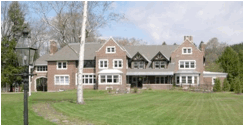 races (some of which Ed officiated).
races (some of which Ed officiated).
Once Frank began remembering, his reportorial instincts kicked in, and he had to nail down a few details. Frank recalled that Ed had lived on the Crane Estate, in Dalton. That family owned the Crane Paper Co., an old and esteemed manufacturing firm in Dalton that among other things made (and possibly still makes) the paper on which US currency is printed. This photo shows "Model Farm" in Dalton, one of several (former) Crane residences there. Frank thought that one of Ed's sisters had married one of the Crane heirs, and Ed (who was a bachelor when we knew him) lived with them on their estate. Frank then did a bit of internet research, found a genealogical site that listed members of the Wilkes family, and confirmed that indeed, Ed's sister Thekla had married Frederick Goodrich Crane, Jr., about 1922. Having validated his memory of that fact with an independent source, Frank passed the information on to me and went back to his day job, reporting on more current events.
But I was just getting started. That genealogical web site provided a lot of information about Ed's family, his parents and four siblings. And somewhat to my/our surprise, it said Ed had been married, to Emily Simmons Ravenel, from 1939 to 1945. It appeared that Ed had had a more interesting life before we met him than we knew about when we knew him, and I set out to learn more about it.
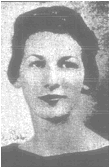
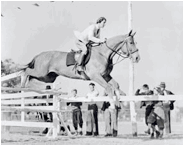 To flesh out that minimal story, I first searched for more information on his ex-wife, Emily. She was not hard to find. Emily was from Charleston, SC, the daughter of a wealthy local farmer and horse trainer. She was a champion equestrian who owned and ran a riding school, an alumna of the Ashley Hall School, a debutante. Their engagement and wedding were among the highlights of the 1939 Charleston social season (her portrait is from the engagement announcement in the Charleston News and Courier.)
To flesh out that minimal story, I first searched for more information on his ex-wife, Emily. She was not hard to find. Emily was from Charleston, SC, the daughter of a wealthy local farmer and horse trainer. She was a champion equestrian who owned and ran a riding school, an alumna of the Ashley Hall School, a debutante. Their engagement and wedding were among the highlights of the 1939 Charleston social season (her portrait is from the engagement announcement in the Charleston News and Courier.)
The best documented part of Emily's life was her second marriage, after she and Ed divorced (more on that later). And the most intriguing part of that story was that upon her death in 2011, Emily left her family papers to the South Carolina Historical Society. An inventory on the SCHS web site describes Box #15 as "Wilkes Family Correspondence, 1946-64." Virginia Gorday, our Peter's wife, is from Charleston, is interested in history, families and genealogy, and is adept at researching those topics. Peter had expressed interest in seeing a memorial for Ed Wilkes. Would they be interested in stopping in at the SCHS on their next visit to SC, and sifting through Box #15 of Emily's papers? Yes, you bet they would. They did that in June, and much of what comes next here has been gleaned from Emily's papers, by the Gordays.
In a letter she wrote to her mother in 1936, Emily said she had had several "dates" with Ed. She was visiting friends in Buffalo and seemed to have known the Wilkes family for a while. She mentioned Ed and his younger brother, Jack, and said Ed (shown at right in a photo from some time around then) was better looking. She remarked on how "cold blooded" northern boys were, sizing up a woman's potential value as a wife before deciding to get serious, whereas in her mind southern boys were much more romantic, falling in love first and only then would they begin to "find out what she was like." She made several jokes about their age difference (he was 38, she was 21.)
have known the Wilkes family for a while. She mentioned Ed and his younger brother, Jack, and said Ed (shown at right in a photo from some time around then) was better looking. She remarked on how "cold blooded" northern boys were, sizing up a woman's potential value as a wife before deciding to get serious, whereas in her mind southern boys were much more romantic, falling in love first and only then would they begin to "find out what she was like." She made several jokes about their age difference (he was 38, she was 21.)
 Unfortunately, we don't have letters documenting their courtship, but when they married, in October 1939, he was still 17 years older, 42 to her 25. We saw no letters from the early years of the marriage, when he was a trust banker in Pittsfield and (perhaps, all we have is Darrow's word for it) in the Navy in WWII. We can surmise that Emily was uprooted from her home and family, living in the frozen North among frozen northerners, with a much older husband, maybe not the comfortable life she wanted. But her papers reveal two themes.
Unfortunately, we don't have letters documenting their courtship, but when they married, in October 1939, he was still 17 years older, 42 to her 25. We saw no letters from the early years of the marriage, when he was a trust banker in Pittsfield and (perhaps, all we have is Darrow's word for it) in the Navy in WWII. We can surmise that Emily was uprooted from her home and family, living in the frozen North among frozen northerners, with a much older husband, maybe not the comfortable life she wanted. But her papers reveal two themes.
First, Ed and Emily lived for two years on the Darrow campus. Her papers include a copy of the Darrow catalogue from about 1945. This is the cover, with her note in the corner, maybe for future historians, "I spent 2 years here with my first husband, Ed Wilkes." She wrote on several other pages, all notes that suggest happy times. Beneath a picture of Ministry House (the Infirmary in our day) she wrote "Where Ed & I lived." A picture of the Dairy, "Where Dottie & John van Vorst lived." A shot of the football field, looking out over the valley, "This was the gorgeous view Ed & I had from our back windows & terrace." She labeled a photo of the ski team coach "One of our dearest friends!" and inscribed beneath a photo of an old building being dismantled by a Hands-to-Work crew that "A swimming pool was made from the basement!"
We aren't sure whether Ministry House was a dorm or the Infirmary in the 1940s; Emily had been trained as a nurse's aide by the Red Cross during the war, and perhaps she was the school nurse. Or maybe she was just a young faculty wife. But she was clearly involved in the life of the school, and popular. Her files include many letters from both Darrow boys (some suggesting they had crushes on her!) and from parents, thanking her for support and kindnesses she had rendered.
However happily Emily may have fit into Darrow life, her marriage to Ed was not working out, and by June of 1945, they were separated, and divorcing. She went back to Charleston, and he went back to living with his sister and brother-in-law in Dalton. Ed also left Darrow after the 1945 school year, and in one of his letters to Emily he offers to "do anything" for her—"with the one exception of going back to Darrow." Perhaps he had left to escape from painful memories, we may never be sure.
The other theme that emerged, from Emily's papers and other things Virginia dug up, was the strength of Ed's family ties. The Crane estate in Dalton, and their summer place on Cape Cod, where Frank and Ed later shot the breeze, were where Ed spent most of his time. Ed's sister Ellen was married at Model Farm in  Dalton in 1932. So was their sister Francesca, in 1928. After Ed and Emily separated in June 1945, when she went back to Charleston, he spent a week with Ellen and her husband, in effect licking his wounds.
Dalton in 1932. So was their sister Francesca, in 1928. After Ed and Emily separated in June 1945, when she went back to Charleston, he spent a week with Ellen and her husband, in effect licking his wounds.
The photo here, thanks to Virginia's research, is Ed's mother, Francesca (Fanny) Adam. (In another shot of her, we can see where Ed got his striking blue eyes.) Ed's father, Edward N. Wilkes (1868-1953), was a banker in Buffalo. Ed was the oldest of five children. The photo below shows him with his father and siblings. Left to right, two Eds (better than one, right?!) Then comes Thekla (1900-1991), who married Frederick G. Crane, lived in Dalton, and provided Ed with a residence for decades. Thekla taught physical education at Miss Hall's, and lived a long notable life as a Berkshires society matron. Thekla's husband, Fred, the scion of the Crane Paper dynasty, an alumnus of Andover and Yale, served in the field artillery in WWI and as a captain in the Navy in the Pacific theater in WWII. In addition to helping run the family paper company, he farmed trees and cattle and like Ed (see later), was an avid sailor, owning a 50-foot cutter and a schooner. He was a skier and one of the original partners in Jiminy Peak. He was also a banker, and served on the board of the bank where Ed worked when he first came to live in the Berkshires. Fred died in 1978; he and Thekla had three children and 13 grandchildren.
 Next to Thekla is their sister Francesca (1902-1994), who was known as Johnny. We don't know much about her, except that she was married to Raymond M. Polley, Sr., lived in Bennington, VT., was widowed in 1964, eventually moved back to Buffalo (perhaps to live with her sister). She lived to be 91, and had two children. Next is Ellen Birks Wilkes (1909-2010), known as Nebby, whose wedding in Dalton to Dr. Ramsdell Gurney was described in the Springfield Union and Republican as "the first important society wedding of spring" (1932) in western Massachusetts, attended by "prominent people" from as far away as Boston and Buffalo. Nebby's husband was a noted local physician in Buffalo for 50 years, until his death in 1990, leaving two children and six grandchildren. Nebby herself lived to 101, and on her death was memorialized as a "pianist, painter, longtime volunteer." She had "excelled at music and art" as a young woman and was an accomplished classical pianist "who later switched to jazz, which she regularly played even at age 100. She was known for her free-wheeling spirit, assertive personality and infectious sense of humor, according to family members." No wonder when Ed was feeling down after his breakup with Emily he chose to spend time with "Ram and Neb."
Next to Thekla is their sister Francesca (1902-1994), who was known as Johnny. We don't know much about her, except that she was married to Raymond M. Polley, Sr., lived in Bennington, VT., was widowed in 1964, eventually moved back to Buffalo (perhaps to live with her sister). She lived to be 91, and had two children. Next is Ellen Birks Wilkes (1909-2010), known as Nebby, whose wedding in Dalton to Dr. Ramsdell Gurney was described in the Springfield Union and Republican as "the first important society wedding of spring" (1932) in western Massachusetts, attended by "prominent people" from as far away as Boston and Buffalo. Nebby's husband was a noted local physician in Buffalo for 50 years, until his death in 1990, leaving two children and six grandchildren. Nebby herself lived to 101, and on her death was memorialized as a "pianist, painter, longtime volunteer." She had "excelled at music and art" as a young woman and was an accomplished classical pianist "who later switched to jazz, which she regularly played even at age 100. She was known for her free-wheeling spirit, assertive personality and infectious sense of humor, according to family members." No wonder when Ed was feeling down after his breakup with Emily he chose to spend time with "Ram and Neb."
At the right in the photo is John Birks Wilkes (known as Jack, 1914-1992). Like Ed and Fred Crane, Jack served in the Navy during WWII, and was on a destroyer at Pearl Harbor when it was attacked. After his discharge in 1946, he settled in Denver, where he taught Latin at Denver Country Day school and later at Littleton High School. We don't know much more about him, except that he left a son, Edward Wilkes, and two grandchildren. The family photo was probably taken around 1950, judging from the hairstyles. Fanny Wilkes, mother of the five siblings, had died very young, in 1927.
Although Ed and Emily may have failed at marriage, he had long and strong ties to his siblings. There are signs that Emily was a welcomed addition to the family. During 1942, she apparently taught riding to the girls at Miss Hall's, possibly because Thekla introduced her to the school. Miss (Margaret) Hall herself, no less, wrote to Emily to express regret when this relationship was being discontinued. And speaking of old school ties, there were two Cranes from Dalton (not Fred, but likely a brother and an uncle) on the Darrow board of trustees when Ed and Emily were living and teaching there.
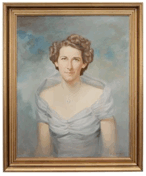 We would be remiss not to close the loop on Emily. After she and Ed divorced and she moved back home, she met, was courted by, and in 1948 she married John Ashby Farrow, known as Ashby, a romantic southerner a few years her junior, who swept her off her feet. (I.e., just the sort of person she probably was destined to be with.) He died in 1984, but she lived to be 96. They owned a Charleston mansion, a prosperous farm and her riding academy; they adopted two sons. In 2008, Emily made an oral history video that's on YouTube (search for Emily Ravenel Farrow). After Ashby passed away, she devoted herself to conservation and historic preservation and was noted for her local philanthropy. Her will left their family farm, Ashem, to a conservation trust, and it's now a county park. She had quite a fabulous life, as Emily Farrow, whose portrait we see here.
We would be remiss not to close the loop on Emily. After she and Ed divorced and she moved back home, she met, was courted by, and in 1948 she married John Ashby Farrow, known as Ashby, a romantic southerner a few years her junior, who swept her off her feet. (I.e., just the sort of person she probably was destined to be with.) He died in 1984, but she lived to be 96. They owned a Charleston mansion, a prosperous farm and her riding academy; they adopted two sons. In 2008, Emily made an oral history video that's on YouTube (search for Emily Ravenel Farrow). After Ashby passed away, she devoted herself to conservation and historic preservation and was noted for her local philanthropy. Her will left their family farm, Ashem, to a conservation trust, and it's now a county park. She had quite a fabulous life, as Emily Farrow, whose portrait we see here.
There are a few letters between Ed and Emily from the 1960s, indicating that they still cared about each other (or had come back to doing so) and felt mutual affection. None of the 1945 letters suggest anger or blame, just a sad realization that the marriage hadn't worked. Their later letters indicate that both were politically very conservative. They echoed McCarthyite "red scare" themes and unease about the civil rights movement. It is almost amusing to note how Ed and Emily compared the first year of JFK's presidency to Nazi Germany—just as today's Democrats have compared Trump's. Almost. But it suggests that our peculiar American hyper-partisan psychosis is not a recent disease, nor perhaps curable.
In Emily's obituaries, Ed is barely a footnote: a single sentence, "Her first husband was Edward N. Wilkes, Jr., of Buffalo, NY." A tribute on FindAGrave.com by her son, David says "After a time in the Berkshires during the second world war, Miss Em returned to teaching at the riding academy…." While Emily and her family may have minimized a short, failed marriage from her youth, it is Ed we care mostly about here, and there is more about him to be told. In addition to Emily's papers, there was a lot more info on the internet, if one knows how to find it. And Virginia does, and did.
Among the materials Virginia unearthed are several news items from the Berkshire Eagle describing Ed's hobbies. His obituary said one of his passions was sailing, which we sort of knew (recall his dominion over the Wainno Yacht Club on Cape Cod). Somewhat oddly, it seems to me, both the news item about his wedding to Emily in 1939 and his obituary in 1967 mention that he was a member of the Royal Canadian Yacht Club of Toronto. Seems like the wrong side of the lake to me, but maybe Toronto had a higher class of yachts than Buffalo; whatever floats your boat, I guess. Emily's letter to her mother in 1936 tells of a sailing trip on Lake Ontario on Ed's 40-foot boat, "a perfect beauty." (They were becalmed and had to be rescued by the Coast Guard.) In a letter to his mother-in-law in 1941, Ed said he was taking "navigation class" and that his instructor had just been called to active duty at the Boston Naval Yard. He observes, "The sailors are leaving the hills for their ships." Other than those vague hints, we have no documentation (there is none in Emily's papers) that Ed actually served in the Navy in WWII; only his Darrow resume mentions it. At 45, he may have been commissioned but not deployed.
Not surprisingly, Ed's other recorded passion was history, and over the years when he lived in Dalton, he spent much of his leisure time digging through historical documents. One story (on Page 1 of the Eagle in 1967, two months before he died) describes Ed as "Professor Wilkes, a retired schoolmaster" and recounts research he was doing into the Rockwell papers, at the Lenox Library. He was reading and cataloguing thousands of documents from an illustrious local family, dating back to the 1700s. Among the more famous Rockwells were a delegate to the Constitutional Convention in 1779, and a judge who opposed adding Texas to the Union in 1845, viewing it as an illegal land grab from Mexico. The story mentioned that Ed could do only a few hours of such research daily, "since eyestrain is considerable in reading the often tiny, sometimes faded handwriting in the letters." Another story in the Eagle, from 1959, described a lecture Ed was giving in Pittsfield about his research on "correspondence accumulated at Crane & Co.," saying he had "uncovered much interesting historical material." 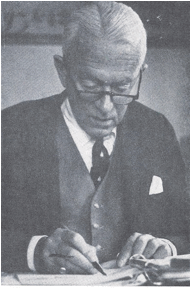
An Eagle article of particular interest noted Ed's retirement from Darrow in 1965. He was "honored for his service to the school at a faculty reception on September 13," and became Darrow's first "emeritus teacher." Unstated in that account is what may have precipitated Ed's departure. When John Joline became head in 1961, he inherited a faculty and administration hired by Lamb Heyniger, including several senior masters who had been there for decades and whose loyalty to a new headmaster roughly half their age was uncertain at best. John understandably wanted to assemble his own team, so he persuaded the Board of Trustees to adopt a mandatory retirement policy, forcing out those 65 and older. Although the primary targets were the Van Vorsts, the Brodheads and Coach Mahnken, Ed may have been swept up in that purge. He was 67 when he "retired."
So, Ed may have left Darrow on somewhat painful terms not once, but twice. At least in 1965 they honored him and made it clear he was welcome to come visit. However, his "retirement" did not last very long. On March 11, 1967, he suffered a heart attack in Dalton and died a few hours later in Pittsfield hospital. Frank speculates that Ed's heart issues could have been smoking-related; he recalls that Ed was a heavy smoker, "He carried a gold cigarette case, he'd tap out his cigarettes on it." Of his five siblings, Ed had by far the shortest lifespan.
This final photo appeared in the Peg Board in 1967, with Peter Schaaphok's eulogy. It captures Ed as we remember him. While I regret that it has taken 50+ years for me to write this memorial, I am very grateful to the collaborators who have contributed to the fuller portrait we now have of the history teacher whose lessons we'll never forget.
Addendum to Ed Wilkes Memorial by Ned Groth, January 26, 2023
I have discovered that I made a mistake in Ed’s memorial – and was guilty of sloppy fact-checking to boot. So, I am compelled to confess and add this mea culpa.
I was going through my yearbooks, looking for something else, and spotted along the way three candid shots of Mr. Wilkes. I recalled that, when I was writing his memorial, I had made a point of how there were almost no photos of him in the yearbooks – because he lived off campus and didn’t participate in most of the routine activities of the community. That much was true, but after including one photo of Ed, in winter garb, a shadowy figure exiting a door, in the memorial, I asserted that, other than portraits in the faculty section, that was the ONLY candid photo of him in any of my yearbooks.
Well, that was wrong. Today I spotted two others. One of them, ironically enough, is in the memorial for Ed – so I must have known that what I wrote wasn’t true when I wrote it. Here’s the other one, which I “found” today, in the 1960 yearbook. True, Ed’s chin is obscured by what I’m pretty sure is Dick Nunley’s hair, but it’s definitely Ed. The picture was taken in Mr. Heyniger’s office (you can see a bit of the curved Meeting House roof out the window) and it includes The Boss, Ron Emery, and Coach Mahnken. It was probably some sort of faculty meeting that the photographer was able to record.
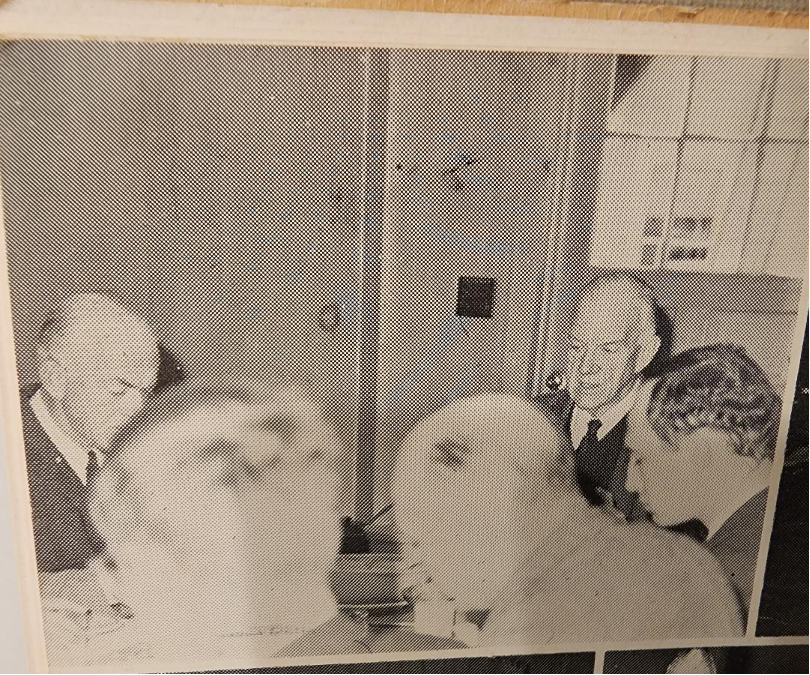
So, I stand corrected. Still darn few candid shots of Ed, but two more than I said.
Home | Class News | 50th Reunion | Past Reunions | Other Gatherings | Newsletter Archive | Links | Memorials | Classmates Search | Classmates Found | Trivia | Former Faculty | Contacts |